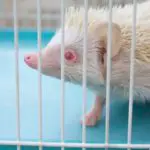
Discover the secrets of a hedgehog nest and learn how to protect these adorable critters if you spot one!
Quick Answer: A hedgehog nest looks like a dome-shaped pile of leaves, grass, and branches. If you find one, observe from a distance and avoid disturbing it.
Key Takeaways:
- A Hedgehog nest is a dome-shaped structure made from leaves, grass, and twigs, often found in sheltered spots like under hedges or in dense shrubbery; if active, they should be left undisturbed to protect the resident hedgehogs.
- If you find a hedgehog nest, assess for danger from predators or environmental hazards and provide food and water without causing dependency; intervention should be minimal unless the hedgehog appears injured or in distress, in which case contact wildlife rescue services.
- Creating a hedgehog-friendly habitat involves building a properly sized and predator-resistant hedgehog house, planting natural cover, and providing food and water; this encourages hedgehog visits and supports their conservation and well-being.
Identifying Hedgehog Nests
When you’re exploring the outdoors or even your own backyard, you might stumble upon a hedgehog nest. These are special little homes where hedgehogs rest, breed, and hibernate. Recognizing a hedgehog nest is key to ensuring these creatures are safe and undisturbed.
Visual Characteristics of a Hedgehog Nest
A typical hedgehog nest has a dome shape and is often well-hidden. The size can vary, but most are big enough to house the small body of a hedgehog, roughly the size of a small melon. These nests are made from natural materials like leaves, grass, and branches that blend into the surroundings. The entrance is usually small and hard to spot. If you see footprints or droppings nearby, it’s a good sign that a hedgehog may be living there. Remember, if you do find a nest, it’s important not to touch it. Hedgehogs are sensitive and might leave their home if they feel threatened.
Common Locations for Hedgehog Nests
Hedgehogs prefer quiet, sheltered spots for their nests. They often choose areas that protect them from predators and harsh weather. Look for nests under hedges, in compost heaps, or within dense shrubbery. If you’re scanning your garden or local green spaces, these are the places to check. Always respect these natural habitats. They are crucial for hedgehog conservation.
Materials Used in Hedgehog Nest Construction
Hedgehogs are resourceful builders. They use leaves, grasses, twigs, and organic debris to construct their nests. These materials provide structure and insulation, especially important during hibernation. In cities, hedgehogs might use garden waste or even discarded litter. To help hedgehogs, leave natural materials in your garden for them to use.
Seasonal Changes in Hedgehog Nesting Behavior
Hedgehog nests change with the seasons. During breeding season, nests might be simpler. But for hibernation, they are sturdier and better insulated. Hedgehogs may switch nests for various reasons, like changing weather conditions or to avoid parasites and diseases. It’s crucial not to disturb nests during hibernation or when hoglets are present.
Distinguishing Between Active and Abandoned Nests
An active nest will have fresh materials, droppings, and tracks. An abandoned nest looks older and lacks recent signs of hedgehogs. If you find an abandoned nest, it’s usually safe to remove it. But if it’s active, it’s best to leave it alone to protect the hedgehogs living there.
What to Do When You Find a Hedgehog Nest
Discovering a hedgehog nest can be an exciting moment. If you find one, the first thing to do is to observe from a safe distance. Look for any signs of distress or danger to the nest. It’s important to minimize human interaction to prevent causing stress to the hedgehogs. Only consider intervention if you notice immediate threats. If you’re unsure, it’s best to contact wildlife rescue services for advice. Remember, there are wildlife laws that protect these creatures and their homes.
Assessing Whether the Nest Is in Danger
To determine if a hedgehog nest is at risk, look for potential threats such as predators, human activity, or environmental hazards. Signs of a nest in danger might include disturbed surroundings or the presence of domestic animals. If you need to secure the area:
- Set up a barrier to keep pets and predators away.
- Move domestic pets indoors to avoid disturbance.
- Contact wildlife experts before deciding to move the nest.
Steps to Take If Hedgehogs Are Present
If you find hedgehogs in the nest, here’s how you can help without causing harm:
- Provide food and water in a way that doesn’t lead to dependency.
- Keep a respectful distance and avoid handling the hedgehogs, especially hoglets.
- Monitor the nest for signs of health issues or distress.
- If necessary, seek help from wildlife professionals.
Educating others about respecting hedgehog nests is also crucial for their protection.
How to Protect Hedgehog Nests from Predators and Hazards
Protecting hedgehog nests from foxes, badgers, and human-related dangers like lawn mowers and pesticides is essential. To safeguard these nests:
- Use natural deterrents to keep predators at bay.
- Maintain a wildlife-friendly garden.
- Create escape routes for hedgehogs.
- Employ humane methods to deter threats.
A balanced ecosystem is beneficial for hedgehogs to thrive.
When and How to Provide Assistance to Hedgehogs
Human intervention may be necessary if a hedgehog is injured or ill. Signs that a hedgehog needs help include lethargy, visible wounds, or being active during the day. To assist:
- Safely capture and transport the hedgehog to a wildlife rescue center.
- Wear gloves to protect yourself and the animal.
- Keep the hedgehog warm and quiet during transport.
Legal Considerations and Wildlife Regulations
Hedgehogs and their habitats are protected by law. It’s important to be aware of wildlife laws and regulations regarding their conservation. These laws may include:
- Restrictions on handling and relocating wildlife.
- Requirements to comply with regulations to support conservation efforts.
- Reporting illegal activities to the authorities.
Being a responsible citizen plays a significant role in wildlife preservation.
The Role of Hedgehog Nests in Their Lifecycle
Hedgehog nests are more than just a bed of leaves; they are a cornerstone in the lifecycle of these charming creatures. From the moment of breeding, through the nurturing of hoglets, and into the depths of hibernation, a secure nest is vital. It’s a sanctuary that ensures the survival of hedgehogs during the harsh months and a nursery for the next generation. Understanding the stages of a hedgehog’s life, from a sprightly juvenile to a hibernating adult, reveals how their nesting behavior adapts to their needs. The continuity of the species hinges on these undisturbed nesting sites.
Nesting as Preparation for Hibernation
As the chill of winter approaches, hedgehogs meticulously prepare their nests for hibernation. The right insulation is crucial, as it helps to maintain a stable temperature while the hedgehog’s body slows down. Materials like dry leaves and grass are often used to reinforce the nest, chosen for their excellent thermal properties. During hibernation, hedgehogs experience significant physiological changes, conserving energy for winter survival. The timing of their nest preparation is often triggered by the shortening days and dropping temperatures, signaling the start of their long winter rest.
The Birth and Development of Hoglets in Nests
Nests play a critical role in the early stages of a hedgehog’s life. Mother hedgehogs craft a secure birthing environment within the nest to welcome their hoglets. These nests are designed to support the growth milestones of the young, from their first blind and deaf days to their initial explorations outside. The safety of the nest is paramount, shielding the hoglets from predators and harsh environmental factors. The early weeks spent in the nest are a time of rapid development, and the protection it offers is essential for their survival.
The Impact of Nesting on Hedgehog Health and Longevity
A well-built nest is a hedgehog’s best defense against the elements and a key factor in their health and longevity. A sturdy nest reduces stress, shields hedgehogs from extreme weather, and helps prevent diseases and parasites. Hedgehogs are diligent about nest maintenance, ensuring their home remains clean and dry to ward off health issues. However, human activities can inadvertently threaten hedgehog habitats. By practicing responsible conservation practices, such as maintaining natural garden areas and being mindful of hedgehog activity, we can help these creatures thrive.
By appreciating the importance of hedgehog nests in their lifecycle, we can take steps to protect these animals and their habitats, ensuring that hedgehogs continue to be a delightful presence in our natural world.
Creating a Hedgehog-Friendly Habitat
Creating a space where hedgehogs can thrive is a rewarding way to engage with nature and help local wildlife. By setting up hedgehog houses, planting natural cover, and providing food and water, you can make your garden a hedgehog haven. This not only gives hedgehogs more nesting options but also shields them from urban threats. Embracing organic gardening practices benefits not just hedgehogs but the entire ecosystem.
Designing and Building a Hedgehog House
A hedgehog house is a fantastic addition to any garden. Here’s how to make one:
- Ensure the dimensions allow enough space for a hedgehog but not so large that it loses its coziness.
- Use sustainable materials like untreated wood.
- Place the house in a quiet part of the garden, sheltered from the elements.
- Make it weatherproof and predator-resistant.
- Design the house for easy cleaning to maintain hygiene.
Plant Choices and Garden Layout for Hedgehog Safety
The right plant choices and garden layout can make all the difference for hedgehogs:
- Choose shrubs and groundcover plants that provide cover and food.
- Incorporate log piles and leaf litter for natural nesting materials.
- Avoid chemicals that could harm hedgehogs.
- Keep the garden clutter-free to allow free movement.
Providing Food and Water for Hedgehogs
Supplementing hedgehogs’ diets with food and water can be a lifeline, especially when their natural sources are scarce. Here’s how to do it right:
- Offer meat-based pet food; never give milk or bread.
- Set up a feeding station that’s safe from other animals.
- Always provide clean, fresh water in a shallow dish to prevent drowning risk.
Encouraging Hedgehog Visits Without Disturbing Their Natural Behavior
Attracting hedgehogs to your garden is about balance. You want to welcome them without disrupting their natural behaviors:
- Leave some areas wild for foraging and nesting.
- Maintain habitat connectivity for hedgehog movement.
- Create hedgehog highways for safe passage between gardens.
- Use wildlife-friendly gardening practices.
By following these guidelines, you’ll not only enjoy the presence of hedgehogs in your garden but also contribute to their conservation and well-being.
Understanding Hedgehog Behavior Related to Nesting
Hedgehogs are fascinating creatures with unique behaviors, especially when it comes to their nesting habits. They exhibit a range of daily and seasonal activities, such as foraging and hibernation, which are crucial for their survival. Although typically solitary, hedgehogs may share nests in certain situations. It’s important to recognize behaviors that signal stress or distress in these animals, as these can indicate underlying issues. Conservation efforts are essential to protect hedgehog habitats and support the species’ continued existence.
Daily and Seasonal Activity Patterns of Hedgehogs
Hedgehogs are primarily nocturnal, active at night when they venture out to forage. Their daily routines revolve around searching for food, such as insects and worms. As the colder weather sets in, hedgehogs begin to focus on building nests that will keep them warm during hibernation. Throughout the year, their activity levels fluctuate with changes in food availability and the need for shelter.
Social Interactions: Solitude and Sharing of Nests
Despite their solitary nature, hedgehogs sometimes share nests. This is more common during the mating season or when environmental conditions are harsh. It’s important for us to respect their need for space and to be cautious not to disrupt their natural behaviors. Human activity can significantly impact hedgehog social interactions, so it’s vital to be mindful of our actions.
Recognizing Signs of Stress or Distress in Hedgehogs
Signs of stress or distress in hedgehogs can include:
- Hesitation to enter their nest.
- Making more noise than usual.
- Being active during the day, which is not typical for nocturnal animals.
These behaviors may be caused by human disturbance, illness, or changes in their environment. To help hedgehogs, we should strive to reduce these stressors and seek help from wildlife professionals if we notice a hedgehog in distress.
The Importance of Conservation Efforts for Hedgehog Habitats
Conservation is key to safeguarding hedgehog habitats. Threats like urban development and habitat fragmentation pose significant risks to hedgehog populations. Here’s how we can help:
- Create and protect natural habitats in our communities.
- Advocate for wildlife-friendly policies and practices.
- Support biodiversity and ecosystem health through our actions.
By understanding hedgehog behavior and supporting conservation initiatives, we can make a positive impact on the future of these charming animals.
Frequently Asked Questions
Question 1:
How can you tell if a hedgehog nest is currently in use without disturbing it? Answer: Look for fresh signs like new leaves, grass, or droppings at the entrance; these indicate an active nest.
Question 2:
Can hedgehogs build nests in urban areas, and what materials do they use? Answer: Yes, urban hedgehogs may use garden waste or discarded litter to construct their nests.
Question 3:
What should you do if a hedgehog nest is accidentally disturbed? Answer: Observe from a distance, minimize further disturbance, and contact wildlife experts if necessary.
Question 4:
How can you differentiate between a hedgehog nest and other animal nests? Answer: Hedgehog nests are dome-shaped and made of leaves, grass, and branches, often with hedgehog tracks nearby.
Question 5:
Are there any specific times of year when you should be extra cautious about disturbing hedgehog nests? Answer: Be extra cautious during hibernation (late fall to early spring) and breeding season (spring to summer).
Read more facts about Hedgehogs here.
Further reading here.









